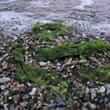Background
- The term spirulina refers to a large number of cyanobacteria or blue-green algae. Both Spirulina spp. and non-Spirulina spp. fall into the classification of cyanobacteria and include: Aphanizomenon spp., Microcystis spp., Nostoc spp., and Spirulina spp. Most commercial products contain Aphanizomenon flos-aquae, Sprirulina maxima, and/or Spirulina platensis. These algae are found in the warm, alkaline waters of the world, especially of Mexico and Central Africa. Spirulina spp. are most often grown under controlled conditions and are subject to less contamination than the non-spirulina species that are harvested naturally.
- Spirulina is a rich source of nutrients, containing up to 70% protein, B-complex vitamins, phycocyanin, chlorophyll, beta-carotene, vitamin E, and numerous minerals. In fact, spirulina contains more beta-carotene than carrots. Spirulina has been used since ancient times as a source of nutrients and has been said to possess a variety of medical uses, including as an antioxidant, antiviral, antineoplastic, weight loss aid, and lipid-lowering agent. Preliminary data from animal studies demonstrate effectiveness for some conditions as well as safety, although human evidence is lacking. Based on available research, no recommendation can be made either for or against the use of spirulina for any indication.
References
- Baicus C, Baicus A. Spirulina did not ameliorate idiopathic chronic fatigue in four N-of-1 randomized controlled trials. Phytother Res 2007 Jun;21(6):570-3.
View Abstract - Hernandez-Corona A, Nieves I, Meckes M, et al. Antiviral activity of Spirulina maxima against herpes simplex virus type 2. Antiviral Res 2002;56(3):279-285.
View Abstract - Iwasa M, Yamamoto M, Tanaka Y, et al. Spirulina-associated hepatotoxicity. Am J Gastroenterol 2002;97(12):3212-3213.
View Abstract - Jensen GS, Ginsberg DI, Drapeau C. Blue-green algae as an immuno-enhancer and biomodulator. J Amer Nutraceut Assoc 2001;3(4):24-30.
- Mani UV, Desai S, Iyer U. Studies on the long-term effect of spirulina supplementation on serum lipid profile and glycated proteins in NIDDM patients. J Nutraceut 2000;2(3):25-32.
- Mathew B, Sankaranarayanan R, Nair PP, et al. Evaluation of chemoprevention of oral cancer with Spirulina fusiformis. Nutr Cancer 1995;24(2):197-202.
View Abstract - Misbahuddin M, Islam AZ, Khandker S, et al. Efficacy of spirulina extract plus zinc in patients of chronic arsenic poisoning: a randomized placebo-controlled study. Clin Toxicol (Phila) 2006;44(2):135-41.
View Abstract - Romay C, Armesto J, Remirez D, et al. Antioxidant and anti-inflammatory properties of C-phycocyanin from blue- green algae. Inflamm Res 1998;47(1):36-41.
View Abstract - Samuels R, Mani UV, Iyer UM, et al. Hypocholesterolemic effect of spirulina in patients with hyperlipidemic nephrotic syndrome. J Med Food 2002;5(2):91-96.
View Abstract - Shih SR, Tsai KN, Li YS, et al. Inhibition of enterovirus 71-induced apoptosis by allophycocyanin isolated from a blue-green alga Spirulina platensis. J Med Virol 2003;70(1):119-125.
View Abstract - Watanabe F, Takenaka S, Kittaka-Katsura H, et al. Characterization and bioavailability of vitamin B12-compounds from edible algae. J Nutr Sci Vitaminol (Tokyo) 2002;48(5):325-331.
View Abstract - Yang HN, Lee EH, Kim HM. Spirulina platensis inhibits anaphylactic reaction. Life Sci 1997;61(13):1237-1244.
View Abstract







